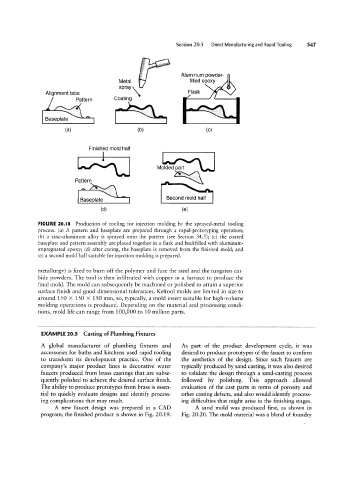Page 567 - 04. Subyek Engineering Materials - Manufacturing, Engineering and Technology SI 6th Edition - Serope Kalpakjian, Stephen Schmid (2009)
P. 567
Section 20.5 Direct Manufacturing and Rapid Tooling 547
Aluminum powder- Q
|\/|era| filled epoxy f
spray W ®
Alignment tabs Flask
Pattern C0al'n9
(H) lb) (C)
Finished mold half
Molded part
Pattern
Second mold half
(Ol) (G)
FIGURE 20.18 Production of tooling for injection molding by the sprayed-metal tooling
process. (a) A pattern and baseplate are prepared through a rapid-prototyping operation;
(b) a zinc-aluminum alloy is sprayed onto the pattern (see Section 34.5); (C) the coated
baseplate and pattern assembly are placed together in a flask and backfilled with aluminum-
impregnated epoxy; (d) after curing, the baseplate is removed from the finished mold; and
(e) a second mold half suitable for injection molding is prepared.
metallurgy) is fired to burn off the polymer and fuse the steel and the tungsten-car-
bide powders. The tool is then infiltrated with copper in a furnace to produce the
final mold. The mold can subsequently be machined or polished to attain a superior
surface finish and good dimensional tolerances. Keltool molds are limited in size to
around 150 >< 150 >< 150 mm, so, typically, a mold insert suitable for high-volume
molding operations is produced. Depending on the material and processing condi-
tions, mold life can range from 100,000 to 10 million parts.
EXAMPLE 20.5 Casting of Plumbing Fixtures
A global manufacturer of plumbing fixtures and As part of the product development cycle, it was
accessories for baths and kitchens used rapid tooling desired to produce prototypes of the faucet to confirm
to transform its development practice. Une of the the aesthetics of the design. Since such faucets are
company’s major product lines is decorative water typically produced by sand casting, it was also desired
faucets produced from brass castings that are subse- to validate the design through a sand-casting process
quently polished to achieve the desired surface finish. followed by polishing. This approach allowed
The ability to produce prototypes from brass is essen- evaluation of the cast parts in terms of porosity and
tial to quickly evaluate designs and identify process- other casting defects, and also would identify process-
ing complications that may result. ing difficulties that might arise in the finishing stages.
A new faucet design was prepared in a CAD A sand mold was produced first, as shown in
program; the finished product is shown in Fig. 20.19. Fig. 20.20. The mold material was a blend of foundry

